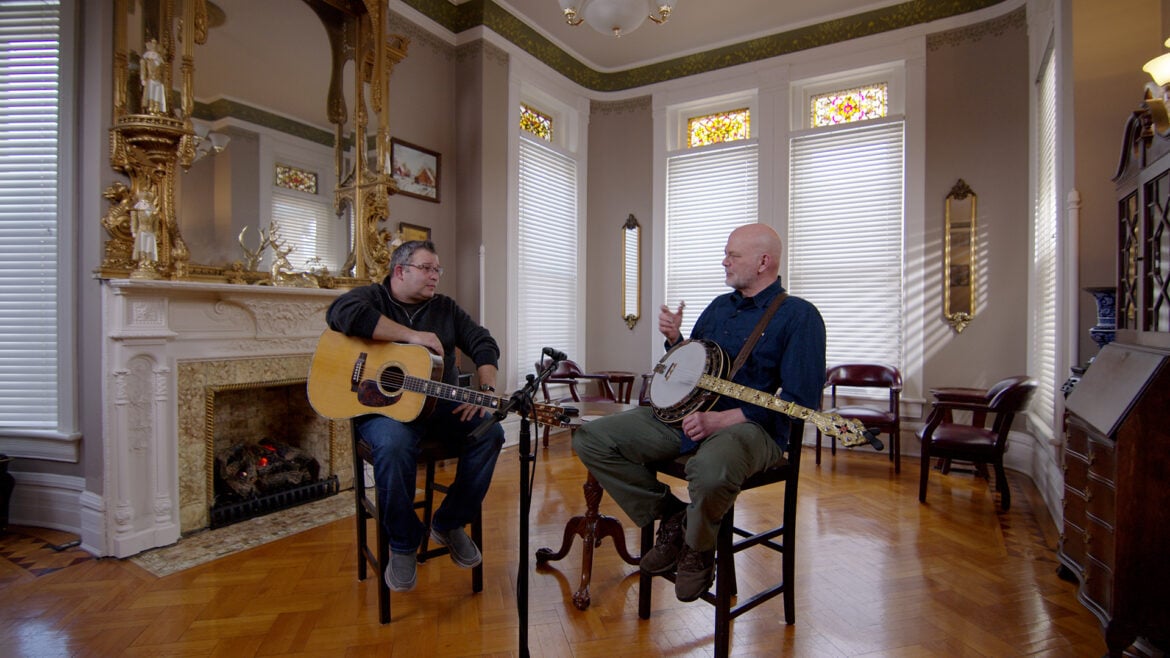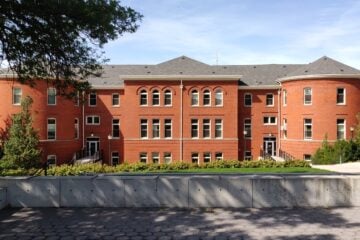All-digital PBS Appalachia Virginia taps into regional pride for programs and funding

Courtesy of PBSAV
Brandon Adams, host of "The Life of a Musician," interviews Lonesome River Band frontman Sammy Shelor in an original production for the digital station.
One drawback to being the first to accomplish something is navigating major roadblocks you can’t foresee. But, for the leaders of the first all-digital public television service in the U.S., a successful launch in June is a source of civic pride and optimism.
PBS Appalachia Virginia, a startup that operates under the umbrella of Blue Ridge Public Television in Roanoke, secured cable carriage for linear TV delivery of its programming, overcame technical challenges with geofencing and landed a new deal to build a state-of-the-art studio within a Hard Rock casino and resort in Bristol, Va.
When PBSAV debuted June 10, its website began offering a livestream of the PBS national schedule and original local programming, along with separate streams of the PBS Kids, World and Create channels. Viewers can also access the programming through a custom PBS Appalachia Virginia app, the PBS video app and PBS Passport membership streaming service.
PBS Appalachia Virginia is also available on regional cable providers Shentel and, through a partnership with Cox Communications, Comcast/Xfinity. The cable companies swapped out Blue Ridge PBS’ position in their channel line-ups with PBS Appalachia Virginia. They are receiving the PBSAV livestream via fiber.

Creation of the all-digital service follows years of efforts to remedy the loss of over-the-air public TV service in rural, mountainous southwest Virginia. The region, which includes 13 counties, has had spotty access to PBS stations’ broadcast signals for more than a decade. After earning $5.8 million in the 2017 FCC spectrum auction, Blue Ridge PBS relinquished its signals and shut down two transmitters that provided public TV broadcast service to Virginia’s southwestern border with Tennessee.
With PBSAV, the Roanoke-based licensee is now working to restore public TV service without all that broadcast infrastructure. Since the digital station delivers PBS’ national programs to a coverage area previously served through cable carriage of Blue Ridge PBS, it is not paying separate program dues, according to GM Julie Newman.
“We have been so fortunate that our communities that we serve have embraced us and welcomed us,” Newman said. “They’ve been yearning and asking for a PBS station for years, and we’re so happy to finally bring them the service they deserve.”
Landing ‘in the best situation’ for new studio
After what Blue Ridge PBS CEO William Anderson called an “incredibly successful” launch, the next major project is building its studio for PBSAV by next summer. Earlier plans to locate a production hub inside the Southwest Virginia Cultural Heritage Center in Abingdon became “too complicated,” Newman said.
Instead, a new partnership with Hard Rock International carves out 4,000 square feet within the Hard Rock Hotel & Casino in Bristol for a glass-encased television and podcast studio, according to a PBSAV news release. In an adjacent control room, resort guests will be able to watch TV productions in progress. The studio will not be located within the casino.
“We really landed in the best situation with the Hard Rock,” Newman said.
In her previous job as a local TV news anchor, Newman reported on construction plans for the resort. When the cultural center deal fell through, she contacted Allie Evangelista, president of Hard Rock Bristol, and a partnership came together. Local businessmen Jim McLaughlin and Clyde Stacy helped fund the studio project.
PBS Appalachia also secured $530,000 from the Virginia Tobacco Commission to invest in equipment. The Virginia General Assembly, which provided $500,000 towards startup during fiscal 2023, may provide another $500,000 in a fiscal 2024 budget that’s not yet finalized.
Building PBSAV as a streaming service is much less expensive than constructing and maintaining new transmitters, Newman and Anderson said. A transmitter system would cost in excess of $1 million because of the forthcoming transition to ATSC 3.0, or NextGen TV, according to Newman. “Considering utilities, land rental, maintenance and having to hire an engineering team, we could be saving over $1.5 million,” she said in an email to Current.
“Remember, we had two transmitters to cover the area before 2013,” Newman added. “When we had those transmitters in place, the coverage was still inadequate because of the mountainous terrain of our region.”
Original productions and new model
For PBSAV’s local productions, Newman prioritized programs that showcase positive aspects of life in Southwest Virginia. As GM, she developed three series that have already debuted their first seasons: Hometowns of Central Appalachia, a show that profiles communities in the region; French Magnolia Cooks, a farm-to-table culinary journey with Chef Missy Wolff Fraley; and The Life of a Musician, an acoustic guitar interview and performance show. Jacob Dellinger, a cinematographer, director and producer, is EP for PBSAV’s original productions. Josh Deel, producer of the YouTube series Exploring Appalachia, joined the team as senior producer this year.

Project Southwest, a channel that will present some of PBSAV’s original productions, features two episodes and the pilot of Hometowns. A second YouTube channel, Storytellers of Appalachia, presents interviews with residents of the region. Newman said her team is considering launching another YouTube channel for a program tentatively called Appalachian Artisans. It would showcase local glass-blowers, painters and other crafts people.
The YouTube channels are part of a strategy to develop revenue streams from content that doesn’t duplicate programming that’s presented on PBSAV’s livestream.
Newman and Anderson at Blue Ridge hope that PBSAV will eventually qualify for CPB’s Community Service Grant program as a separate station, they said. Because the service transmits programming through streaming technology, not broadcast signals, it doesn’t meet basic CSG criteria.
For the same reason, PBSAV participates in other public TV affinity groups, including America’s Public Television Stations, the National Educational Telecommunications Association and the Small Station Association, as an associate member. However, the digital station was accepted for full membership in the National Academy of Television Arts and Sciences, the Virginia Association of Broadcasting and the National Association of Broadcasting.
Even though the service and business models for their all-digital TV service are works in progress, Anderson and Newman said they won’t be surprised if leaders of other public media organizations try to replicate what they’re building with PBSAV. GMs from stations that serve large geographical areas have already inquired about what they’re doing.
“Blue Ridge PBS was charged with serving 42% of the geographic commonwealth, and you have a lot of PBS stations that cover very vast territories, including some pretty remote areas,” Newman said. Station leaders have told her, “Once you guys work this out and prove that it’s sustainable, we’d love to hear how you did it,” she said.
“I think … we may end up being consultants in the future,” Anderson said.






